Technologies
Best Flip Phone of 2023
The Galaxy Z Flip 5 is our favorite, but there are other choices worth your attention.
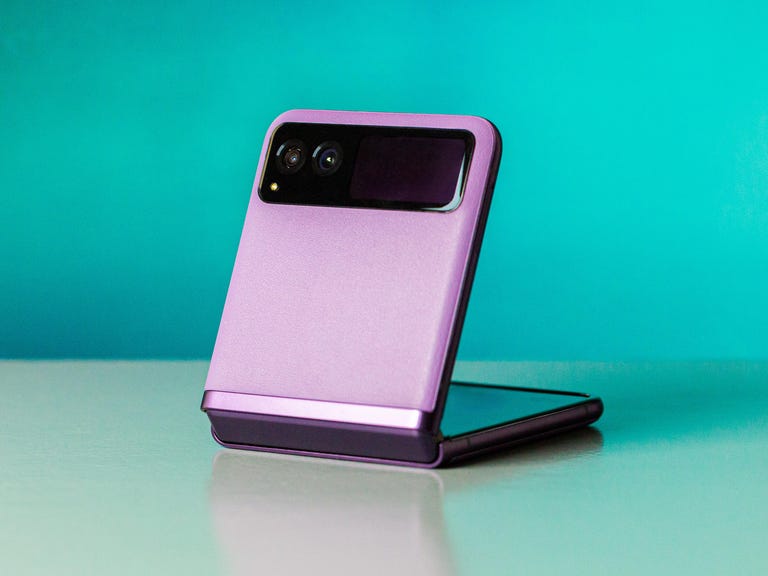
 Why You Can Trust CNET
Why You Can Trust CNET
Years of Experience
Hands-on Product Reviewers
Sq. Feet of Lab Space
Flip phones ruled the early 2000s, and now companies like Samsung, Motorola and Oppo have been bringing them back. But with a modern twist.
Flip phones with bendable screens have been around for the last several years, but they took a leap forward in 2023. The Galaxy Z Flip 5 and Motorola Razr Plus gained larger screens than their predecessors, making them more useful when closed. Oppo’s recently announced Find N3 Flip has an additional camera among other improvements.
While expensive and generally more fragile than standard phones, flip phones provide some benefits you can’t get with regular devices. They fit more easily in your pocket and are more manageable to use with one hand when closed. You can also prop them up by folding them halfway, which makes it possible to take a photo or view the screen without having to hold the device. They also have a distinct design that makes them stand out from other smartphones.
However, if you don’t care about those factors, you should consider one of the cheaper, nonfoldable devices listed in our best phones guide. If you’re considering buying a flip phone in 2023, here are your best options.
What is the best flip phone for most people?
The Galaxy Z Flip 5 is CNET’s top flip phone pick for 2023. It was a close call between Samsung’s new flip phone and the similarly priced Motorola Razr Plus. But Samsung’s design feels more sturdy, the camera takes more colorful photos and the company provides Android version updates for a longer period of time compared to Motorola, making it our favorite choice. Samsung also has a history of rolling out new features to its phones over time through updates to its One UI software, giving it another advantage.
Best flip phones of 2023
The Galaxy Z Flip 5 is the biggest leap forward Samsung’s flip phone has seen in years. Samsung has significantly expanded the size of the cover screen located on the outside of the device, meaning you can look up directions, take photos and send messages without opening the phone. It’s this, combined with the Z Flip’s solid battery life and sturdy design, that makes it a top pick.
The Z Flip 5 may be our favorite flip phone, but there are still some drawbacks to be aware of. At $1,000, it’s still expensive for a phone without a telephoto camera. And not all apps work natively on the front screen as they do on the Motorola Razr Plus. Read our Galaxy Z Flip 5 review.
Pros:
- Big cover screen is fun to use
- New hinge eliminates the gap when closed
- Solid battery life
- More storage in base model
Cons:
- Expensive
- Not all apps work on the cover screen natively
- Apps don’t transition from main screen to cover screen
- Minimal camera updates
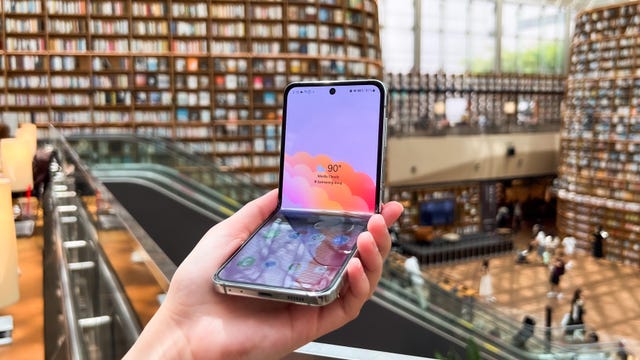
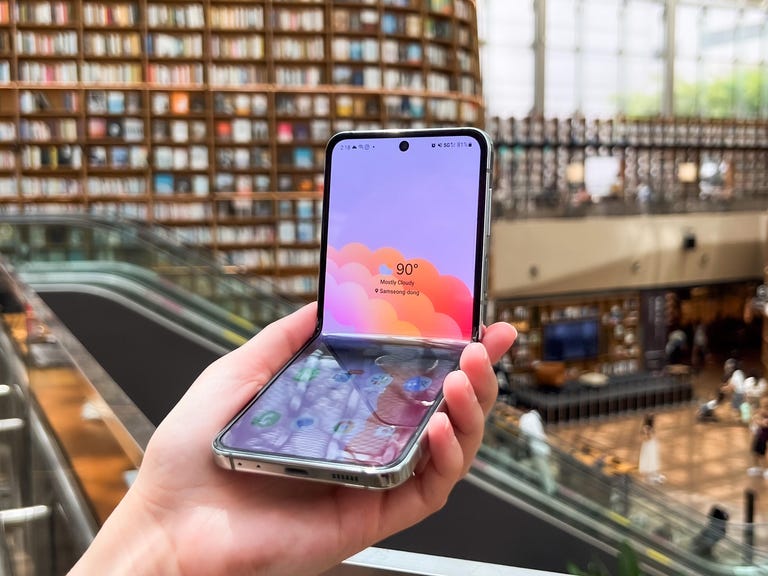
Best compact flip phone
Motorola Razr Plus
The Motorola Razr Plus raised the bar for what a flip phone should be in 2023. Its 3.6-inch cover screen allows you to use almost any app without opening the phone, plus battery life is long enough to get you through a busy day. It’s also thinner than the Galaxy Z Flip 5, which could make it the ideal choice for those who prioritize portability in a phone.
While I recommend the Galaxy Z Flip 5 as the best flip phone overall, the Razr Plus is worth considering if you prefer a thinner design and want to use more apps on the phone’s front screen without much extra fuss. The Razr Plus felt more fragile than the Z Flip 5 during my testing, but it’s certainly thinner, making it a great choice for those who care about compactness above all else. Read our Motorola Razr Plus review.
Pros:
- Large, useful cover screen
- Crease is barely visible
- Thin design
- Good battery life
- Fun photography features like photo previews
Cons:
- Not as many Android updates as Samsung
- Flex View feels limited
- Front screen gathers fingerprint smudges easily
- $1,000 is still expensive


The new Motorola Razr Plus
Best flip phone with a telephoto camera
Oppo Find N3 Flip
Oppo’s Find N3 Flip phone is unique for two reasons: It has a telephoto camera and a vertical cover screen, unlike the Samsung Galaxy Z Flip 5 and Motorola Razr Plus. That could make the Find N3 Flip an ideal choice for those who want closer zoom shots, although this phone also shines for its fast performance, stylish design and speedy charging. The crease on the interior screen is also impressively subtle. That said, there are some downsides to be aware of. The Find N3 Flip lacks wireless charging, and you’ll only be able to buy it in certain markets, which doesn’t include the US. Read our review of the Find N3 Flip.
Pros:
- Cover screen supports Google Calendar, Gmail and other third-party apps
- Addition of a telephoto lens
- Improved durability IPX4 rating
Cons:
- Obvious branding
- Raised edges of cover screen
- No wireless charging

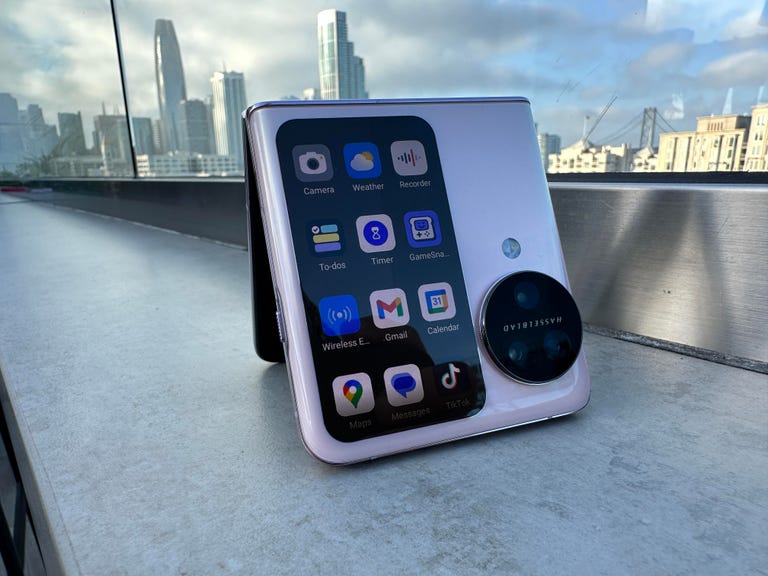
Here’s a sampling of apps you can use on the cover screen of the Find N3 Flip.
Best foldable for budget buyers
Motorola Razr 2023
The Motorola Razr 2023 is the most affordable, widely released foldable phone with a $700 price tag, notably below the $1,000 prices of clamshell foldables like the Razr Plus and Samsung Galaxy Flip 5. Motorola made some obvious compromises for affordability, like losing its competitors’ full-front screen for a small 1.5-inch thumbnail-size external display.
Less obvious are more painful shortfalls: three years of Android OS updates and 128GB of nonexpandable storage (you’ll have to rely on cloud storage if you go over). If you can stomach those compromises, the Razr 2023 is a great phone with a svelte design, large 6.9-inch internal display and sharp 64-megapixel main camera (the less said about its other ultrawide lens, the better). It’s a phone that suits a specific niche: Folks who want to try out foldables for a few years, but don’t want to shell out a lot of money if they’re still iffy on whether this «flexible display» thing will take off.
Pros:
- Solid and svelte build quality
- Great main camera
- Fun foldable functionality
- Good price
Cons:
- 128GB onboard storage is limited
- Outer screen is very small
- 3 years of OS updates is less than competitors
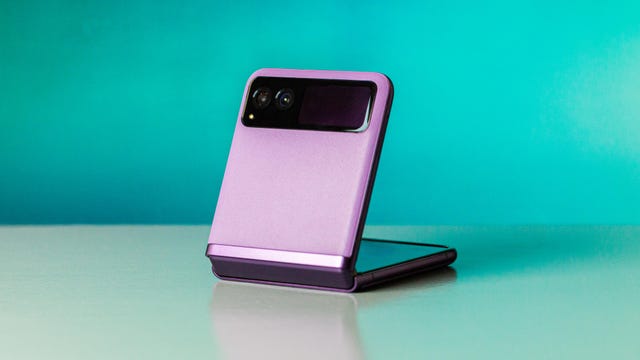

How to buy a new phone
Know what you care about most: Is it screen size? Camera quality? Battery life? This will help narrow down your choices. If you’re interested in a foldable phone, design and screen size should be more important to you than camera quality
Don’t discount the midrange: Features of last year’s flagships always trickle down to this year’s midrange handsets.You can get a great phone that does almost everything that a premium phone can do for a fraction of the price. Google’s Pixel 7 Pro packs a great zoom camera, but the base Pixel 7 has most of the same key specs and comes at a more reasonable price. But if you’re trying to save a few bucks, you shouldn’t be considering a flip phone. Devices like the Galaxy Z Flip 5 and Motorola Razr Plus are priced like high-end premium phones, although Motorola plans to release a cheaper Razr this year.
Shop the sales: Look for deep discounts and promo deals around major holidays, especially Amazon’s Prime Day and Black Friday. And find out what your grace period is in case you need a quick return or exchange.
Last year’s phones: They can often be a great deal, too. Wait for this year’s launch to get last year’s phone for less, when stores and carriers may be trying to offload their existing stock. However, keep in mind you’ll miss out on the spacious cover screens found on the Galaxy Z Flip 5 and Razr Plus by going for last year’s models.
Hold the phone in hand at a store first: You may love or hate the way it looks and feels in person. This is especially important for flip phones and other foldable devices, particularly if it’s your first time using one.
Check if you’re already invested: Have you already bought a lot of iPhone apps and iTunes movies? Stick with an iPhone if you still want access to them. Likewise, if you’ve invested in loads of Android apps, you’ll want to stay on that side of the fence. Otherwise, it’s simple enough to switch platforms. However, those interested in flip phones only have Android devices to choose from for now.
Buy a case and screen protector: You’ll protect your phone from costly damage, and will increase the phone’s resale or trade-in value for when you’re ready to move on.
How we test phones
We test every phone in real-world scenarios, focusing on its features, design, performance, cameras, battery life and overall value. We document our findings in an initial review that is periodically updated when there are new software updates, or to compare it against new phones from competitors such as Apple, Samsung, Google and OnePlus. Below is our methodology for testing smartphones in general, which also applies to flip phones.
Photography
Photography is a major focus for most phones these days, so we take pictures and videos of various subjects in a variety of settings and lighting scenarios. We try out any new camera modes, such as Action mode that debuted with the iPhone 14 line, or the Unblur photo tool that launched with the Google Pixel 7 series.
Battery life
Battery testing is conducted in a variety of ways. We assess how long a phone lasts during a typical day of use and note how it performs during more focused sessions of video calls, media streaming and gaming. We also conduct a video playback test, as a simple, replicable measure of pure battery life, which isn’t always included in the initial review but sometimes added later in an update.
Performance measuring
We use benchmarking apps to measure each phone’s performance, alongside our own anecdotal experiences using the phone for our review. Of note are how graphics and animations look. Are they smooth? Or do they lag or stutter? We also look at how quickly the phone switches between horizontal and vertical orientations, and how fast the camera app opens and is ready to take a photo.
We perform processor-heavy tasks like editing photos, exporting videos and playing games. We evaluate whether a newer version of a particular phone includes enough features to make it worth upgrading from older models.
Read more: How we test phones
Flip phone FAQs
Technologies
Today’s NYT Connections Hints, Answers and Help for Nov. 25, #898
Here are some hints and the answers for the NYT Connections puzzle for Nov. 25, #898

Looking for the most recent Connections answers? Click here for today’s Connections hints, as well as our daily answers and hints for The New York Times Mini Crossword, Wordle, Connections: Sports Edition and Strands puzzles.
Today’s Connections: Sports Edition is both fun and tricky. Think colors, and see if you can find items that share the same color. The purple category wants you to look within four words and find a connecting word hidden in them. If you’re struggling with today’s puzzle but still want to solve it, read on for hints and the answers.
The Times now has a Connections Bot, like the one for Wordle. Go there after you play to receive a numeric score and to have the program analyze your answers. Players who are registered with the Times Games section can now nerd out by following their progress, including the number of puzzles completed, win rate, number of times they nabbed a perfect score and their win streak.
Read more: Hints, Tips and Strategies to Help You Win at NYT Connections Every Time
Hints for today’s Connections groups
Here are four hints for the groupings in today’s Connections puzzle, ranked from the easiest yellow group to the tough (and sometimes bizarre) purple group.
Yellow group hint: Not big.
Green group hint: These things are the same color.
Blue group hint: Itchy!
Purple group hint: They all share words that are positive.
Answers for today’s Connections groups
Yellow group: Small-time.
Green group: Things that are pink.
Blue group: Things you can scratch.
Purple group: Starting with optimistic words.
Read more: Wordle Cheat Sheet: Here Are the Most Popular Letters Used in English Words
What are today’s Connections answers?
The yellow words in today’s Connections
The theme is small-time. The four answers are Mickey Mouse, rinky-dink, trivial and two-bit.
The green words in today’s Connections
The theme is things that are pink. The four answers are Barbie Dreamhouse, calamine lotion, cherry blossom and flamingo.
The blue words in today’s Connections
The theme is things you can scratch. The four answers are bug bite, lottery ticket, vinyl record and your head.
The purple words in today’s Connections
The theme is starting with optimistic words. The four answers are glad-hand, Happy Meal, merry-go-round and sunny-side up.
Technologies
I’m Buying These Headphones for My Gamer Thanks to This Deep Black Friday Discount
SteelSeries headphones are among the top gaming headsets on the market and right now you can score them for as much as half off ahead of Black Friday.
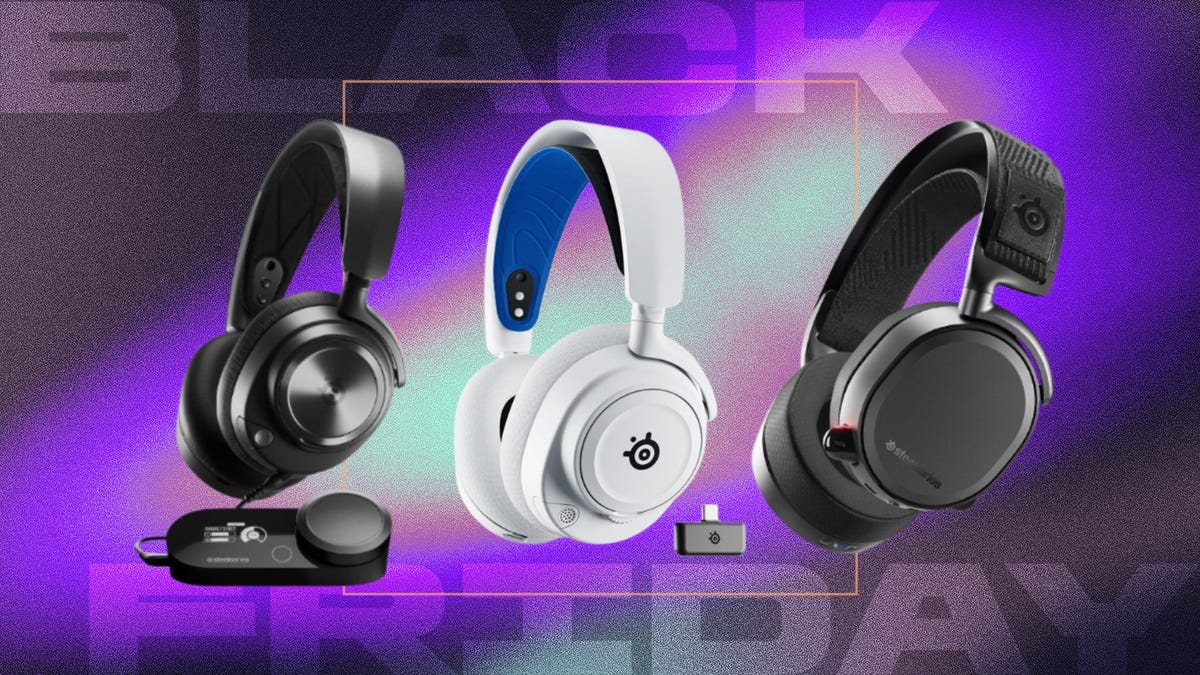
Ready or not, Black Friday is just about here. And Black Friday deals are already popping up on the regular.Here at CNET, we offer our services as dedicated deal finders, scouring the market to curate the best offers for you. We recently spotted some of our favorite gaming headsets on sale at Amazon, some of them for more than half off. We don’t know if these prices will last all the way to Black Friday itself, so if you see something you like, we suggest grabbing it sooner rather than later.
Right now, several SteelSeries’ most popular gaming headsets are seeing nice discounts. I’ve highlighted some of the best offers below, including the ones in my own cart right now, but be sure to check out the Amazon page to see all the options.
First up, the headset in my cart right now as as a holiday gift for my discerning teenage son is the SteelSeries Arctis Nova 3x wireless gaming headset, currently down to just $90, a $20 savings. Arctis Nova 3x comes in blue, black or white and is compatible with Xbox, PC, PS5, Switch and mobile and has a whopping 40-hour battery life. They are lightweight and have a stretchy headband for added comfort.
If you want to go pro, check out the SteelSeries Arctis Nova Pro wireless headset, down to $290 from $380. That’s nearly $100 off a multi-platform compatible headset good for Xbox, Switch, PS5, PS4, PC and mobile. This headset was our sibling site, PCMag’s top pick for best overall gaming headphones. It boasts active noise cancellation, 360-degree spatial audio and a ClearCast Gen 2 mic. Only the black variant is currently on sale at this big of a discount.
Essentially a more affordable version of the above, the Arctis Nova Pro wired headset for Xbox is down to $150, which is $100 off the regular price of $250. This one also got PCMag’s seal of approval for best wired gaming headphones.
Buyers should note that a few of the headsets on sale are renewed, so be sure to double check before buying. We’ve also rounded up the best Black Friday headphone deals if you’re in the market for something for an audiophile near you.
CHEAP GAMING LAPTOP DEALS OF THE WEEK
-
$900 (save $300)
Why this deal matters
Gaming headphones come in a wide range of styles and price points, but the best ones factor in three key components: sound quality, battery life and comfort — those all-night gaming sessions pretty much demand it. Over the years, we’ve tested a ton of brands, and SteelSeries frequently comes out on top, especially for PC and Xbox users. Being able to pick up a pair at a discount makes it a great opportunity to gift or grab a new headset that delivers on comfort, sound and quality.
Join Our Daily Deals Text Group!
Get hand-picked deals from CNET shopping experts straight to your phone.
By signing up, you confirm you are 16+ and agree to receive recurring marketing messages at the phone number provided. Consent is not a condition of purchase. Reply STOP to unsubscribe. Msg & data rates may apply. View our Privacy Policy and Terms of Use.
Technologies
Oura’s CEO Has Some Chill Advice for Avoiding Health-Tracking Anxiety
For the leading smart ring maker, «calm tech» seems to be the winning strategy.

When I sit down with Oura’s CEO, Tom Hale, in a quiet wooden booth on the outskirts of the Web Summit technology conference in Lisbon, I notice that he’s wearing two smart rings. Is he conducting competitor analysis? No, it turns out. Both of the rings are his own company’s devices.
One, he explains, is his personal ring, which contains all his data from the past four years. The second is linked to his beta account and shows him what’s coming in the next software update.
For Hale, wearing two rings that run two sets of software allows him to be plugged into every minuscule variation in data. This type of hyperfocus, essential for his job with the world’s leading smart ring maker, enables him to understand the ever-evolving experience of Oura customers before they do.
But being on high alert is not what he wants for the rest of us. Quite the opposite, in fact.
«Our philosophy very much is about being in the background,» says Hale. «We think of ourselves as calm tech.»
Don’t miss any of our unbiased tech content and lab-based reviews. Add CNET as a preferred Google source.
Calm tech is a departure from the majority of other wearable devices on the market, and it seems to be resonating. Over the past year, smart rings, which primarily measure activity and sleep, have surged in popularity, with sales more than doubling to 1.8 million units in 2024, and expected to hit around 4 million units this year, according to Omdia.
Many of us are choosing them over the best fitness trackers. Smart rings accounted for 75% of all fitness tracker revenue in the US this year, up from 46% the previous year, according to Circana.
Unlike standard fitness trackers, smart rings can’t provide real-time feedback, stats and coaching on your wrist. Instead, they record and synthesize your activity and sleep data for viewing on your phone at a later time. That’s enough for most people. The trade-off is especially worth it for those of us who want to nurture a less anxious attachment style to our personal tech and prioritize a real-world focus.
The majority of other wearables on the market aren’t conducive to this «passive» relationship. Smartwatches — and, for the most part, smart glasses — are body-worn screens, contributing to the ever-increasing and omnipresent information overload that tech subjects us to.
Easing health tech anxiety
Smart rings are, by their very nature, screen-free devices, and Oura wants to keep it that way. The Oura Ring 4 doesn’t include any flashing lights and indicators (it does have LEDs on the inside for measuring heart rate and blood oxygen). That decision was geared toward maintaining peace of mind, according to Hale.
«A lot of the most engaging and demanding applications are ones notifying you and creating anxiety where it doesn’t need to be there,» he says. «‘Oh, your heart rate’s elevated. You’re dying.’ Who needs that message? I don’t need that message.»
I don’t need it either. I’m far from alone in feeling that unfettered health tracking can quickly descend into an anxiety-inducing nightmare that causes more harm than good. Obsessing over not getting enough sleep has been known to induce insomnia. Intensive calorie tracking can cause people to disregard their bodies’ signals and ignore hunger cues.
This, Hale tells me, is what Oura strives to avoid. When the company introduced meal tracking into its app earlier this year, it was careful about how it framed the feedback, focusing on «gentle» advice.
The feature allows you to upload a picture of your food and input a brief description, before it’s scanned by AI and given a rating: nutritious, good, fair or limited. I raise my eyebrow at the inclusion of «good» as a rating. It could read as assigning a moral value to the food you’ve eaten. But Oura chose not to include a «bad» rating, which takes some of the sting out of it.
Oura also tries to steer people away from focusing on assigning a numerical value to their food, «which I think lends itself to sort of obsessive behaviors,» says Hale. You can see caloric intake if you wish, but Oura also offers a switch to let you turn off any mention of calories.
«For some people, counting calories is really triggering,» says Hale. «We try to be very sensitive to that, because we don’t want to create an unhealthy relationship with it, and we don’t want to shame people.»
For Oura customers to get the most out of their ring and subscription, Hale’s No. 1 tip is not to put too much value on a single health metric, but instead to take a holistic approach to the information to guide their actions. (Oura provides data on 40 different activities under its $6/£6 per month fee. By contrast, the Samsung Ring offers more limited tracking, free of charge.)
Hale says the company is not focused on measuring bodies. «We’re in the behavior-change business,» he says.
In the case of food, this might work by observing how your body reacts to what you’re eating and then examining how that reaction intersects with other factors, such as whether you’re rested, stressed or have exercised earlier that day.
Hale shows me a picture of the Portuguese flan he’d eaten the night before while in Lisbon. «Shocker,» he says, «look at my blood sugar spike.»
There’s nothing wrong with having the flan — it certainly doesn’t seem to have subdued Hale, who is animated and full of energy throughout our conversation. But seeing the impact of a rich, sugar-heavy meal late in the evening after a busy day at a tech event might help you understand how you feel, or even nudge you into eating differently the next day to balance things out.
‘It’s going to be OK’
Oura’s goal is to build context around why your body might be behaving a certain way, and increasingly, provide personalized, generative AI support via an LLM-powered chatbot that you can talk to about injuries and offer tailored advice. This, too, can help relieve any stress you might be feeling about your health, says Hale.
«One of the things that we try to do is strike a supportive tone in the AI, to kind of be like: ‘You had a bad night’s sleep, but it’s going to be OK.'» he says.
The AI Oura Advisor, which the company launched in summer 2024, can prompt the kind of behavior change Hale wants for Oura customers, such as suggesting you take a walk after a heavy meal to aid digestion. It even takes into account one frequently overlooked element of long-term health — social connection — and will prompt you to spend time with friends and family.
Over the past few years, there has been an explosion in longevity culture, with people investing money in products and services, like supplements and wellness services, that promise to extend their life and health spans.
The «moral hazard» of these products, says Hale, is that there’s no accountability. «If it works, great,» he says. «If it doesn’t work, you’re not gonna call me. You know why? Because you’re dead.»
Oura doesn’t exclude itself entirely from the conversation around longevity. Back in May, it released an ad that Hale calls «cheeky,» featuring older adults wearing Oura rings and living their best lives. But it didn’t promise we’d all become centenarians.
«Our premise is not: Hey, buy our supplement because you want to live forever,» says Hale. «Our premise is: Change your behavior today to make healthy choices, because then you’ll live a better life.»
It’s a convincing pitch, which might explain why Oura surpassed 5.5 million total rings sold back in September, putting it on track to hit $1 billion in revenue for the first time this year. According to the latest stats shared by the International Data Corporation, published in 2024, the company boasted an 80% market share.
Last month, the company scored a «decisive victory» in a patent infringement lawsuit against two of its competitors, Ringconn and Ultrahuman. So when Hale tells me he doesn’t test rivals’ rings «as much as he used to» because they’re «copying us,» I know it’s more than bravado.
Thanks to its intellectual property and growing troves of health data that enable it to refine its software, Oura has a clear competitive advantage in this rapidly growing market.
«I’m looking not for other things that other people are doing,» Hale says. «I’m looking for the stuff that we should do that’s really innovative.»
Disclosure: Katie Collins traveled to Lisbon as a guest of Web Summit to serve as a panel moderator. Her reporting from the event was independent of that role.
-

 Technologies3 года ago
Technologies3 года agoTech Companies Need to Be Held Accountable for Security, Experts Say
-

 Technologies3 года ago
Technologies3 года agoBest Handheld Game Console in 2023
-

 Technologies3 года ago
Technologies3 года agoTighten Up Your VR Game With the Best Head Straps for Quest 2
-

 Technologies4 года ago
Technologies4 года agoBlack Friday 2021: The best deals on TVs, headphones, kitchenware, and more
-

 Technologies4 года ago
Technologies4 года agoVerum, Wickr and Threema: next generation secured messengers
-

 Technologies4 года ago
Technologies4 года agoGoogle to require vaccinations as Silicon Valley rethinks return-to-office policies
-

 Technologies4 года ago
Technologies4 года agoOlivia Harlan Dekker for Verum Messenger
-

 Technologies4 года ago
Technologies4 года agoiPhone 13 event: How to watch Apple’s big announcement tomorrow


